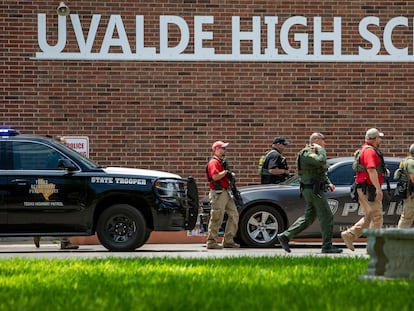Uvalde: School shootings as a US norm
Survivors, families of victims, parents and communities have demanded action on gun violence for years, but they have gone unheard once again


Although the installation of metal detectors and the adoption of other security measures such as video cameras or backpack searches have contributed to the decrease in the number of shootings in educational centers, the massacre that Salvador Ramos perpetrated this Tuesday in an elementary school in Uvalde (Texas), which has left at least 18 children and two adults dead, bears the signature of a tragedy foretold.
Mass shootings have become a sinister pattern at elementary schools, middle schools, high schools and universities in the United States. Two were registered in September alone , also in Texas, after the total or partial closure of educational centers due to the pandemic temporarily stopped the bleeding. The trend resumed on the last day of November with a deadly attack in Oxford, Michigan, when a 15-year-old boy, also a student, killed four high school classmates. The teen used a weapon that had been legally purchased by his father, and the authorities announced that from then on the parents or guardians would be charged and tried for the criminal actions of the minors in their care.
The Michigan attack was by no means the most deadliest; the cases of Sandy Hook or Parkland, scenes of two separate shootings with a shocking trail of fatalities, have remained in the memory of parents, fearful of a bloodbath in the centers their children attend, as well as those who defend a much stricter regulation of access to weapons, in what has become a very bitter political and ideological battle.
On December 14, 2012, a young man named Adam Lanza killed 26 people: 20 students, mostly young children, and six teachers at Sandy Hook Elementary School in Newtown, Connecticut. To the balance must be added the lives of Lanza, who committed suicide, and his mother, whom he had killed before undertaking the massacre as if he had to get rid of an obstacle in his way. It was a Friday, in the midst of the usual anticipation that precedes the weekend. Lanza used a nine-millimeter gun, like the Oxford murderer, although he also used a rifle owned by his mother to open fire on the entrance doors to the school. His action, premeditated according to the prosecution, became the deadliest shooting in an elementary, middle or high school in the US, and the fourth committed by a single person. There were over 450 students enrolled at the school, and the security protocols - a video camera - had been updated shortly before the massacre.
On February 14, 2018, a sullen, gun-obsessed former student killed 17 people (two more than Columbine in 1999, including the two teenage assailants) at a Parkland, Florida, high school. a center with 3,200 students that had expelled the murderer a year earlier for indiscipline and problematic behavior. The shooter threw smoke bombs to create confusion, fired an assault rifle and was detained outside the school after an uneasy hour-long wait. Nikolas Cruz, 19, had started a junior military training program after leaving high school, Pentagon sources reported at the time.
Cruz shot outside and inside the educational compound, indiscriminately, at children and at teachers or auxiliary personnel. He had threatened his classmates in the last months he attended school, and school officials had prohibited him from entering the center with a backpack, according to local media. None of the survivors was greatly surprised that Cruz was the author of such carnage: “Many had said it before. Everyone had foreseen it,” said a student. Cruz had posted threatening messages on social networks, but nobody noticed the potential risk that his anger with the world posed.
According to FBI records, from the Columbine massacre in 1999 to 2016, 50 attacks or attempted attacks with a firearm were recorded in US schools, with a balance of 141 dead. Including the Parkland shooting, in the first month and a half of 2018 there were 18 incidents involving firearms at schools across the country.
Parkland’s attack marked a turning point, for better and for worse. For worse, because months after the event, two survivors ended up committing suicide, in the same week. The hashtag #17plus2 was then popularized to reflect the last victims, afflicted according to psychologists by survivor’s guilt syndrome. Those two victims were a young woman whose closest friend was killed in the shooting, and the father of one of the slain students. The only positive consequence of the tragedy was the constitution and mobilization of an activist group, March for Our Lives, made up of students from the attacked high school and which is still active, as evidenced on May 14 when the group demonstrated against the poor control of weapons that makes these events possible, following the shooting in a supermarket in Buffalo that left 10 people dead
In the last two decades there have been too many cases. From the first major one, the Columbine massacre, through Virginia Tech in 2007, when a student named Seung Hui Cho killed 32 people, including students and teachers, before committing suicide. Nine dead at a school on an Ojibwe Indian reservation two years earlier; seven, including the killer, at an Illinois college in 2008; another seven in 2012 at a private university in Oakland; 10 people, including the attacker, in Oregon in 2015; a Santa Fe high school, the same year as the Parkland tragedy. In many cases, the repercussions are ongoing as the pain of survivors and families of the victims persists. The gunmaker Remington will compensate families of Sandy Hook massacre victims after reaching a $73 million settlement agreement in February with nine families who lost loved ones in the shooting. The reason for the compensation was the fact that assault rifles were sold to civilians.
Among the testimonies collected after an event of this nature, what always stands out is what surviving students have to say about the training they receive periodically to know how to face and repel an attack with a firearm. Hiding under tables, barricading themselves in classrooms with locked doors, locking themselves in bathrooms… protection is already a compulsory subject in the US and American children regularly participate in drills. But not even this kind of preparation was able to save the lives of 14 children and one adult in Uvalde.
Tu suscripción se está usando en otro dispositivo
¿Quieres añadir otro usuario a tu suscripción?
Si continúas leyendo en este dispositivo, no se podrá leer en el otro.
FlechaTu suscripción se está usando en otro dispositivo y solo puedes acceder a EL PAÍS desde un dispositivo a la vez.
Si quieres compartir tu cuenta, cambia tu suscripción a la modalidad Premium, así podrás añadir otro usuario. Cada uno accederá con su propia cuenta de email, lo que os permitirá personalizar vuestra experiencia en EL PAÍS.
¿Tienes una suscripción de empresa? Accede aquí para contratar más cuentas.
En el caso de no saber quién está usando tu cuenta, te recomendamos cambiar tu contraseña aquí.
Si decides continuar compartiendo tu cuenta, este mensaje se mostrará en tu dispositivo y en el de la otra persona que está usando tu cuenta de forma indefinida, afectando a tu experiencia de lectura. Puedes consultar aquí los términos y condiciones de la suscripción digital.
More information
Archived In
Últimas noticias
Venezuela hardens its ‘revolutionary state’ project amid pressure from Trump
Sydney Sweeney, the actress praised by Trump: ‘Women are up against what society wants them to be’
The Bolsonaro surname: An advantage or liability in Brazil’s 2026 presidential elections?
Raúl Rocha, from jet-setting with Miss Universe to arms trafficking and fuel theft
Most viewed
- Reinhard Genzel, Nobel laureate in physics: ‘One-minute videos will never give you the truth’
- Pablo Escobar’s hippos: A serious environmental problem, 40 years on
- Charles Dubouloz, mountaineering star, retires at 36 with a farewell tour inspired by Walter Bonatti
- Why we lost the habit of sleeping in two segments and how that changed our sense of time
- The fall of a prolific science journal exposes the billion-dollar profits of scientific publishing










































